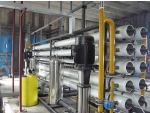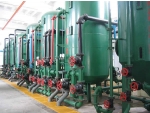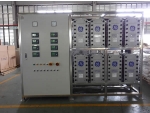

Our state-of-the-art regeneration plant ensures that each regenerated batch of media yields maximum throughput performance. Furthermore, all freshly regenerated media...
Mixed bed demineralizer consists of single vessels containing both cation and strong base anion resins. Mixed bed produce water with the highest purity, which typically ranges from 200,000 up to 18,000,000 ohms, cm.

EDI (Electrodeionization) is a revolutionary water treatment technology; it is a membrane filtration and desalination technology that skillfully combined the electrodialysis technology ...
EDI (Electrodeionization) is a revolutionary water treatment technology; it is a membrane filtration and desalination technology that skillfully combined the electrodialysis technology and ion exchange technology together, which is high-tech, green and eco-friendly technology.
All natural water contains dissolved mineral salts. While in solution, these salts separate into positively charged cations and negatively charged anions. Through the process of ion exchange, demineralization can significantly reduce the levels of these ions, thereby lowering the conductivity.
The process begins when raw water is passed through cation exchange resin. The cation resin is in the hydrogen form (H+) and exchanges all the positively charged ions for hydrogen, thus converting all the impurities in the water into acids. The acidic effluent water from the cation exchange is then passed through anion exchange resin. The anion resin is in the hydroxyl form (OH-) and exchanges all the negatively charged ions into the hydroxyl form, completing the conversion of all impurities into water (H+ + OH- → H2O), thus providing pure demineralized water.
Dual bed demineralization & deionization systems use separate tanks: one containing cation resin, the other containing anion resin. A weak base dual-bed demineralizer produces water with a resistance of approximately 50 kOHM/cm, and strong base dual-bed units produces water with a resistance of about 200 kOHM/cm.
Mixed bed demineralization & deionization systems utilize a single vessel, to thoroughly mix both the cation and anion resins. The mixed resin configuration produces a much higher water quality than a conventional dual-bed system. In fact, our typical mixed-bed demineralizers are designed to produce water with resistance greater than 18 megOHM/cm.
Common Applications of Demineralization & Deionization Systems
• Power generation
• Industrial process
• Ultrapure polishing
• High pressure boiler makeup
Typical Features of Demineralization & Deionization Systems
• Welded and powder coated steel skid frames
• High quality rubber lined steel or FRP pressure vessels
• High quality ion exchange resins
• Schedule 80 PVC internals and manifold plumbing
• High quality actuated control valves
• Control panel fabrication
• PLC/HMI/VFD controls
• Flow transmitters
• Pressure transmitters
• Acid/caustic transmitters
• Resistivity transmitters
• Sampling ports
• Skid mounting (pre-plumbed, pre-wired & tested)
• Chemical feed pumps
Optional Features of Demineralization & Deionization Systems
• Pressure vessels
• Stainless steel and internal distributors
• Stainless steel skid frames
• Recirculation pumps (for polishing effluent to desired quality)
• Neutralization systems